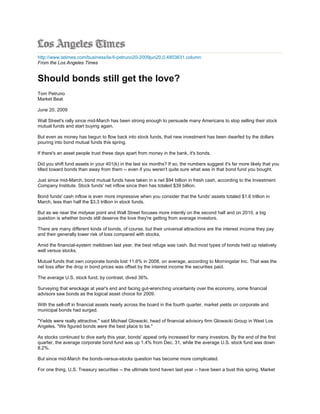
Should Bonds Still Get The Love Petruno La Times 06 20 2009
- 1. http://www.latimes.com/business/la-fi-petruno20-2009jun20,0,4803631.column From the Los Angeles Times Should bonds still get the love? Tom Petruno Market Beat June 20, 2009 Wall Street's rally since mid-March has been strong enough to persuade many Americans to stop selling their stock mutual funds and start buying again. But even as money has begun to flow back into stock funds, that new investment has been dwarfed by the dollars pouring into bond mutual funds this spring. If there's an asset people trust these days apart from money in the bank, it's bonds. Did you shift fund assets in your 401(k) in the last six months? If so, the numbers suggest it's far more likely that you tilted toward bonds than away from them -- even if you weren't quite sure what was in that bond fund you bought. Just since mid-March, bond mutual funds have taken in a net $94 billion in fresh cash, according to the Investment Company Institute. Stock funds' net inflow since then has totaled $39 billion. Bond funds' cash inflow is even more impressive when you consider that the funds' assets totaled $1.6 trillion in March, less than half the $3.3 trillion in stock funds. But as we near the midyear point and Wall Street focuses more intently on the second half and on 2010, a big question is whether bonds still deserve the love they're getting from average investors. There are many different kinds of bonds, of course, but their universal attractions are the interest income they pay and their generally lower risk of loss compared with stocks. Amid the financial-system meltdown last year, the best refuge was cash. But most types of bonds held up relatively well versus stocks. Mutual funds that own corporate bonds lost 11.6% in 2008, on average, according to Morningstar Inc. That was the net loss after the drop in bond prices was offset by the interest income the securities paid. The average U.S. stock fund, by contrast, dived 36%. Surveying that wreckage at year's end and facing gut-wrenching uncertainty over the economy, some financial advisors saw bonds as the logical asset choice for 2009. With the sell-off in financial assets nearly across the board in the fourth quarter, market yields on corporate and municipal bonds had surged. "Yields were really attractive," said Michael Glowacki, head of financial advisory firm Glowacki Group in West Los Angeles. "We figured bonds were the best place to be." As stocks continued to dive early this year, bonds' appeal only increased for many investors. By the end of the first quarter, the average corporate bond fund was up 1.4% from Dec. 31, while the average U.S. stock fund was down 8.2%. But since mid-March the bonds-versus-stocks question has become more complicated. For one thing, U.S. Treasury securities -- the ultimate bond haven last year -- have been a bust this spring. Market
- 2. yields on longer-term Treasuries have jumped, pushing down prices of older bonds, amid the government's record borrowing wave and as some investors have dumped Treasuries in favor of riskier assets. Mutual funds that own longer-term government bonds have lost 2.6% year to date, on average, according to Reuters/Lipper. Tax-free municipal bonds had been stellar performers this year as market yields dropped and older bonds rose in value. But munis hit a rough patch beginning in mid-May as yields began to rise again, in part pushed up by higher Treasury yields. California munis have led the recent market sell-off as the state's budget woes have deepened. Corporate bonds, particularly high-yield junk issues, have continued to rack up strong returns this spring as market yields have fallen. But lower interest rates have reduced the income appeal of corporates. The annualized yield on an index of 100 junk bonds tracked by KDP Investment Advisors was 17.7% in mid-December. Now it's 10.7%. If we simplify the bonds-versus-stocks score card by pitting the Vanguard Total Bond Market Index fund against the Vanguard Total Stock Market Index fund, stocks are well in the lead year-to-date: Total Stock is up 4.5% compared with 1.1% for Total Bond. But among actively managed funds, the story isn't so clear-cut. The biggest bond fund of all, Pimco Total Return, is up 5.1% this year. Tim Kochis, who helps oversee $4 billion as a principal at wealth manager Aspiriant in San Francisco, says bonds naturally have a place in most portfolios. But he worries that many investors are overcommitted now. "People develop a new theme and then overdo it," Kochis said. He expects the economy to show signs of turning up in the second half, and believes that will mean "a huge amount of money coming into the equity market." For bond investors, a recovery would bring to the fore the issue of inflation and whether it's headed higher or lower. Rising inflation historically has been Public Enemy No. 1 for most types of bonds because it erodes the value of fixed- rate returns. Still, some financial advisors say they remain content to lean heavily toward bonds and other lower-risk investments. That's the stance of Eric Bruck, a principal at Silver Oak Wealth Advisors in Los Angeles. His firm got out of stocks almost entirely last summer and is staying out for now, Bruck said. He believes the economy faces too many head winds to mount a significant recovery any time soon. "We think this stock rally is a product of wishful thinking," Bruck said. "We see no real drivers of growth." Compared with the risk of another slump in equities, he said, yields on high-quality bonds continue to offer decent returns -- and peace of mind. tom.petruno@latimes.com